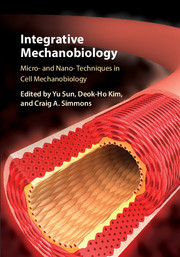Book contents
- Integrative Mechanobiology
- Integrative Mechanobiology
- Copyright page
- Contents
- Contributors
- Preface
- Part I Micro-nano techniques in cell mechanobiology
- Part II Recent progress in cell mechanobiology
- 12 Forces of nature
- 13 Mechanobiological stimulation of tissue engineered blood vessels
- 14 Bone cell mechanobiology using micro- and nano-techniques
- 15 Molecular mechanisms of cellular mechanotransduction in wound healing
- 16 Micropost arrays as a means to assess cardiac muscle cells
- 17 Micro- nanofabrication for the study of biochemical and biomechanical regulation of T cell activation
- 18 Study of tumor angiogenesis using microfluidic approaches
- 19 Neuromechanobiology of the brain
- Index
- References
19 - Neuromechanobiology of the brain
Mechanics of neuronal structure, function, and pathophysiology
from Part II - Recent progress in cell mechanobiology
Published online by Cambridge University Press: 05 November 2015
- Integrative Mechanobiology
- Integrative Mechanobiology
- Copyright page
- Contents
- Contributors
- Preface
- Part I Micro-nano techniques in cell mechanobiology
- Part II Recent progress in cell mechanobiology
- 12 Forces of nature
- 13 Mechanobiological stimulation of tissue engineered blood vessels
- 14 Bone cell mechanobiology using micro- and nano-techniques
- 15 Molecular mechanisms of cellular mechanotransduction in wound healing
- 16 Micropost arrays as a means to assess cardiac muscle cells
- 17 Micro- nanofabrication for the study of biochemical and biomechanical regulation of T cell activation
- 18 Study of tumor angiogenesis using microfluidic approaches
- 19 Neuromechanobiology of the brain
- Index
- References
Summary
This chapter discusses recent progress and future directions regarding mechanobiology as applied to neuronal function. Along with the generation and transduction of mechanical forces by neuronal elements, the influence of mechanical forces on the neuronal membrane, actin, and ion channels is highlighted. Further topics such as cortical folding and traumatic brain injury expand discussion of the role of mechanical forces into a more macroscopic scale. As the mechanical properties of the nervous tissue environment and other mechanical cues influence neural development and contribute to the regulation of endogenous brain function, there is great utility in investigating the mechanical properties of the central nervous system. Through discussion of the role of mechanical forces in neural elements, and early biophysical formulations to understand neural systems that incorporate mechanical analysis, this chapter hopes to encourage expansion of studies and methods investigating mechanobiology applied to the nervous system.
- Type
- Chapter
- Information
- Integrative MechanobiologyMicro- and Nano- Techniques in Cell Mechanobiology, pp. 347 - 367Publisher: Cambridge University PressPrint publication year: 2015



